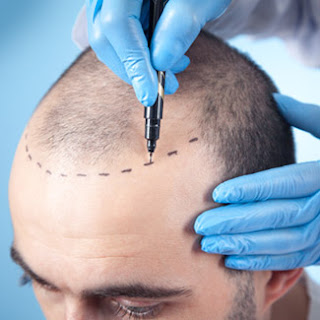How Do FUE And FUT Hair Transplants Differ From One Another?
Hair loss may affect everyone, and it influences the individual's physical appearance as well as emotional and psychological well-being. Dr. Akangsha Sharma provides the Best Hair Transplant in Jaipur.
A hair transplant is the only hair restoration surgery that offers long-term and positive results. Hair is transplanted from the donor area, which has thicker hair, and replaced in the thinning or bald parts of the scalp during the hair transplant operation.
FUE and FUT are two traditional hair transplant procedures. However, people often get confused between both. So, let's learn the difference between the two in this blog.
FUE Hair transplant procedure:
FUE (Follicular Unit Extraction) is a hair transplant procedure in which individual hair follicles are extracted from the donor region and transplanted into the recipient area. Here's a step-by-step guide to FUE hair transplantation:
Donor area preparation: Before the surgery, the donor area (typically the back or sides of the scalp) is trimmed to make extraction simpler. After that, the donor area is cleansed and sterilized.
Anesthesia: Both the donor and recipient sites are numbed using local anesthesia. To ensure that one is comfortable and has as little discomfort as possible during the treatment.
Follicle extraction: The surgeon extracts individual hair follicles from the donor region using a specialized micro-punch instrument (usually 0.6mm to 1.0mm in diameter). Depending on the surgeon's method, the instrument may be operated manually or motorized. The surgeon uses a micro-punch to make tiny circular incisions around each follicular unit (which contains one to four hairs). After that, the follicular units are gently retrieved from the scalp. The surgeon may employ magnification instruments to help with extraction accuracy.
Donor area management: After extracting the follicular units, the surgeon exerts pressure or employs procedures such as electrocauterization to reduce bleeding in the donor region. Depending on the size and quantity of retrieved grafts, the donor region may be sutured or allowed to heal spontaneously. After the extraction, the surgeon prepares the recipient region by making small incisions or tiny holes with a thin needle or blade. These recipient sites are carefully planned to promote natural-looking hair growth and correct angulation.
Graft placement: The harvested follicular units are carefully implanted one by one into the recipient sites. To ensure accurate and exact implantation, the surgeon may utilize forceps or implanters. To establish a natural hairline and appropriate density in the recipient area, the grafts are dispersed equally.
To know the hair transplant cost in Jaipur, one can visit the AK Aesthetic Clinic.
FUT hair transplant procedure:
Another popular hair transplant procedure is FUT (Follicular Unit Transplantation). Unlike FUE, which involves the individual extraction of hair follicles, FUT involves the excision of a strip of scalp from the donor region containing hair follicles. An outline of the FUT hair transplant technique follows:
Donor area preparation: The donor region (usually the back or sides of the scalp) will be clipped to a short length on the day of the surgery. The surgeon will then numb the donor site with local anesthesia.
Donor strip removal: After anesthetizing the donor area, the surgeon will gently remove a strip of scalp containing hair follicles from the donor area using a knife. The length and breadth of the strip are determined by the amount of grafts required as well as the flexibility of the scalp. After removing the strip, the surgeon will seal the donor region with stitches or staples. The closure technique used may differ according to the surgeon's preference and the demands of the patient.
Donor strip dissection: A team of technicians thoroughly dissects the extracted strip of scalp under a microscope. They will cut the strip into individual follicular units, each with one to four hairs. After that, the follicular units are prepared for transplantation.
Recipient site creation: The surgeon will prepare the recipient area by creating small incisions or tiny cuts with a delicate needle or blade while the technicians are dissecting the donor strip. These recipient sites are designed to promote natural hair growth and appropriate angulation.
Graft placement: After preparing the recipient sites, the surgeon or his team will painstakingly put the divided follicular units into the recipient sites. They will make certain that the grafts are placed at the proper depth, angle, and density to obtain natural-looking results.
The decision between FUT and FUE should be reviewed with a trained hair transplant surgeon, taking into consideration the unique circumstances and goals.
To learn more about hair transplants, get a consultation with Dr. Akangsha Sharma, the Best Cosmetic Surgeon in Jaipur. Book an appointment now.


Comments
Post a Comment